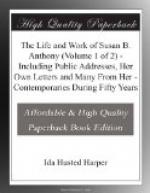The last battle for 1868 was made in what was known as the Hester Vaughan case. When Anna Dickinson lectured in New York before the Workingwoman’s Association she told the story of Hester Vaughan: A respectable English girl, twenty years old, married and came to Philadelphia only to find that the husband had another wife. She then secured employment at housework and was seduced by a man who deserted her as soon as he knew she was to become a mother. She wandered about the streets and finally, in the dead of winter, after being alone and in labor three days, her child was born in a garret and she lay on the floor twenty-four hours without fire or food. When discovered the child was dead and the mother had nearly perished. Circumstances indicated that she might have killed the child. Four days after its birth, she was taken to prison, where she was kept for five months, then tried, found guilty and sentenced to be hanged. She had now been in jail ten months.
The Revolution and the Workingwoman’s Association, headed by Miss Anthony, took up the case, not so much because of the individual as to call attention to the wrongs constantly perpetrated against woman. They created such a public sentiment that a great meeting was held in Cooper Institute, where Horace Greeley presided and a number of well-known men and women took part, including Mrs. Stanton, Mrs. Rose, Dr. Lozier and Eleanor Kirk.[47] Speaking briefly but to the point Miss Anthony submitted resolutions demanding that women should be tried by a jury of their peers, have a voice in making the laws and electing the officers who execute them; and declaring for the abolition of capital punishment. These were adopted with enthusiasm and the meeting, by unanimous vote, asked the governor of Pennsylvania for an unconditional pardon for the girl, while over $300 were subscribed for her benefit. Through Miss Anthony arrangements were made for Mrs. Stanton and Elizabeth Smith Miller to carry to Governor Geary a memorial from the Workingwoman’s Association in behalf of Hester Vaughan. During their interview the governor declared emphatically that justice never would be done in such cases until women were in the jury-box. These efforts, supplemented by others afterwards made in Philadelphia, resulted in his granting the pardon, and the girl was assisted back to her home in England.
Although The Revolution suffered the anxieties inseparable from the launching of a new paper, it found much reason for encouragement. A number of prominent men and newspapers, during the year, had come out boldly in favor of woman suffrage and there seemed to be a considerable public sentiment drifting in that direction; but there were signs even more hopeful than these. Immediately upon the assembling of Congress, in December, 1868, Senator S. C. Pomeroy, of Kansas, presented a resolution as an amendment to the Federal Constitution providing that “the basis of suffrage in the United States shall be that of citizenship; and all native or naturalized citizens shall enjoy the same rights and privileges of the elective franchise; but each State shall determine by law the age,” etc.




